This is an Ambi Silette, a 35mm interchangeable lens rangefinder camera made by AGFA Camera-Werk AG Muenchen between the years 1957 and 1961. Upon it’s release, the Ambi Silette was AGFA’s top of the line 35mm camera and would be the best featured rangefinder model they would ever make. Featuring a unique interchangeable lens mount with 4 available focal lengths and a clever viewfinder with automatic parallax correction and user selectable frame lines, it was a well built camera that offered comparable features to more expensive German rangefinders. It was sold in both Europe and the United States, but unlike many other AGFA cameras that were imported to the US, it was distributed by AGFA directly, and not through ANSCO.
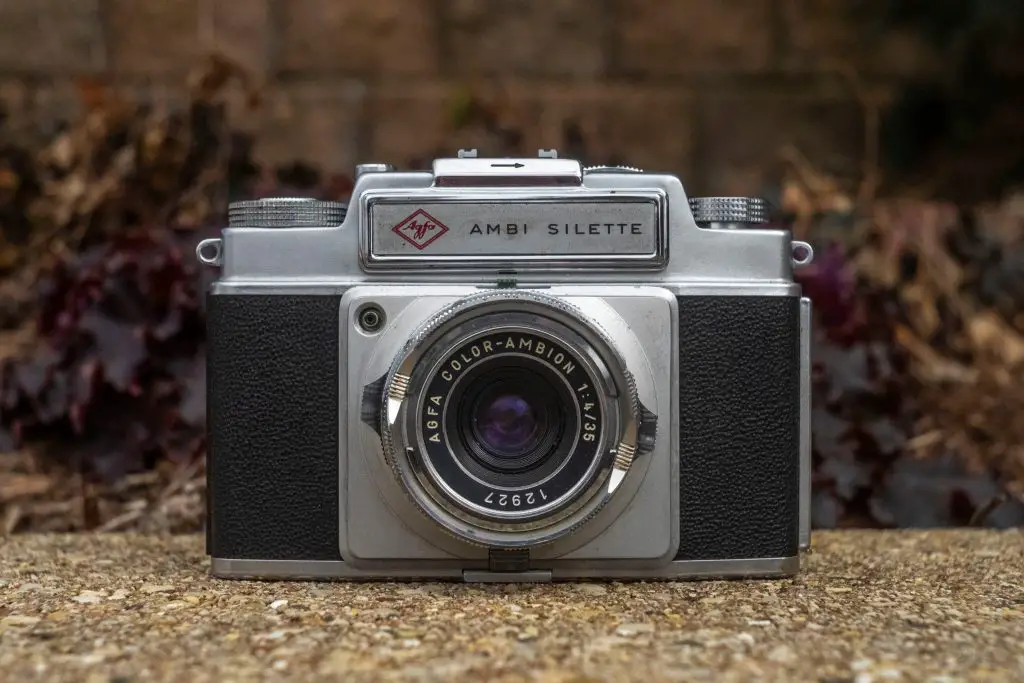 Film Type: 135 (35mm)
Film Type: 135 (35mm)
Lens: 35mm f/4 AGFA Color-Ambion coated 4-elements
Lens Mount: AGFA Silette Clamp Mount
Focus: Variable
Viewfinder: Coincident Image Coupled Rangefinder w/ Selectable 35, 50, and 90 mm Frame Lines
Shutter: Synchro-Compur Leaf
Speeds: B, 1 – 1/500 seconds
Exposure Meter: None
Battery: None
Flash Mount: Coldshoe and M and X Flash Sync
Manual: https://www.pacificrimcamera.com/rl/01496/01496.pdf
Manual (Slightly Different): http://www.urmonas.net/manuals/ambisil.pdf
How these ratings work |
The AGFA Ambi Silette was an advanced and very well built interchangeable lens 35mm rangefinder built by AGFA starting in 1957. At the time of it’s release, it was AGFA’s top of the line camera, and eventually would come with 4 different lenses. It has a large and bright viewfinder with variable frame lines for different focal lengths and was parallax corrected. Each of the lenses available for the system were quite good, and combined with the camera’s competitive feature set, offered a terrific bargain for photographers wanting German quality and flexibility, but without paying “Leica prices”. The camera is a relative bargain today, but being a leaf shutter, sometimes can be hard to find in good working condition. | ||||||
| Images | Handling | Features | Viewfinder | Feel & Beauty | History | Age | |
| 2 | 1 | 2 | 2 | 2 | 0 | 30% | |
| Bonus | none | ||||||
| Final Score | 11.7 | ||||||
History
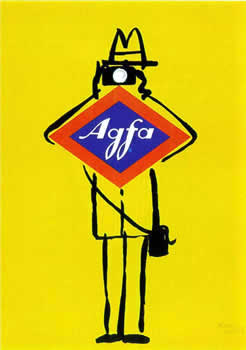 Think about a German made 35mm rangefinder camera from the 1950s with an interchangeable lens mount, and a viewfinder with automatic parallax correction and variable projected frame lines for a variety of different focal lengths. Can you picture it in your head? Was it made by Ernst Leitz or Voigtländer? No? What if I told you this camera originally sold for about $130?
Think about a German made 35mm rangefinder camera from the 1950s with an interchangeable lens mount, and a viewfinder with automatic parallax correction and variable projected frame lines for a variety of different focal lengths. Can you picture it in your head? Was it made by Ernst Leitz or Voigtländer? No? What if I told you this camera originally sold for about $130?
Assuming you’ve already seen the large picture and title of this review above, there’s likely little suspense here, so of course I’m talking about the AGFA Ambi Silette!
If you look back at the history of interchangeable lens 35mm cameras, you’ll notice that there weren’t many options prior to 1956 and almost all of them had focal plane shutters. Despite existing since the 1930s, focal plane shutters were still very expensive to build and most smaller German and Japanese companies didn’t have a lot of experience with them.
Leaf shutters weren’t ideal for an interchangeable lens system as the optics required a much larger opening than a typical 35mm leaf shutter could provide. Zeiss designer Hubert Nerwin attempted to work around this with the release of the Tenax II in the 1930s by using a larger medium format leaf shutter and limiting the exposed image size to 24mm x 24mm to avoid vignetting.
This all changed in 1956 when F. Deckel released a behind the lens variant of it’s Compur leaf shutter that eliminated many of these challenges. As a result, several West German camera companies announced at Photokina 1956 their intention to build several new interchangeable lens leaf shutter cameras using Deckel’s new shutter.
AGFA certainly was no stranger to making high quality cameras like the Karat series and a large number of folding plate cameras before the release of the Ambi Silette, but by the mid 1950s, their reputation as a top tier camera maker was on the decline. The Japanese photo industry was rapidly entrenching on German marques and what was once a large number of successful German makers, was being reduced to a few.
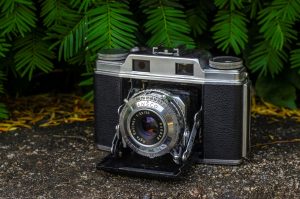
Still, in 1957 when the Ambi Silette made it’s debut, it was a bit of a “last hurrah” for the company with a feature set that closely mimicked that of much more expensive cameras. The Ambi Silette was part of AGFA’s popular Silette series which was introduced in 1953 with the original AGFA Silette, a simple fixed lens 35mm scale focus camera. Later Silettes were upgraded with rangefinders and exposure meters, and some were even sold in the United States under the name of the ANSCO Memar and Super Memar.
The word “Ambi” in the camera’s name is likely taken from the Latin prefix “ambi-” which means “both” or “more than one” and references the camera’s ability to support more than one focal length.
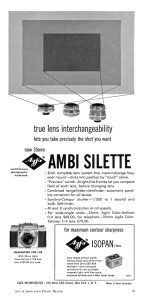
Of the various Silette models produced during the 1950s, the Ambi Silette most closely resembles the AGFA Silette SL, with it’s similar body shape, film advance lever, and flip up door. The Ambi Silette not only added an all new interchangeable lens mount with a small variety of lenses to choose from, but the viewfinder had an innovative design which allowed three different focal lengths of frame lines to be selected. Regardless of which frame lines you use, they were all automatically corrected for parallax error and had a bright and easy to use coincident image rangefinder patch in the center.

Perhaps the camera’s most amazing feature, wasn’t one that had anything to do with the camera itself, but rather was an incredible Lifetime Guarantee given by AGFA to every model sold. Most of the period advertising I’ve found references this lifetime guarantee, but doesn’t reveal any specifics as to what AGFA considers to be “lifetime” as I doubt I’d still be able to get one serviced today. Strangely, the camera’s user manual makes no reference to this guarantee, so perhaps this was something applied by American distributors, rather than AGFA themselves.
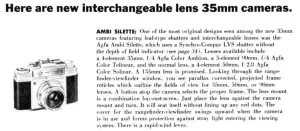
The Ambi Silette made it’s debut at Photokina in October 1956 and likely went on sale in early 1957. At least one site online suggests the US sale date was 1959, which I do not agree is correct. Upon it’s release, it was the first camera that AGFA sold in the United States after the war under it’s own name, rather than as a rebranded ANSCO.
When it was first sold, the Ambi Silette came with a 50mm f/2.8 Color-Solinar for $129. The 35mm f/4 Color-Ambion wide angle lens being reviewed here was an additional $69. When adjusted for inflation, those prices compare to $1165 and $625 today. Although expensive by today’s standards, the Ambi Silette could be obtained for a fraction of what a Leica M3 or Voigtländer Prominent cost.
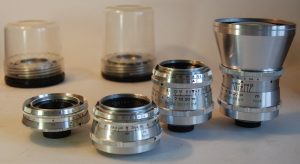
In total, 4 lenses were released for the Ambi-Silette. In addition to the 50mm and 35mm lenses was a 90mm f/4 Color-Telinear and a 130mm f/4 Color Telinear which made it’s debut in 1959. Since the camera did not have internal frame lines for the 130mm lens, it was sold with an auxiliary viewfinder that mounted to the cold shoe. The 35mm, 50mm, and 90mm all shared the same 35.5mm screw in or 37mm press on filter ring, which meant that all available lens accessories could be interchanged between the three lenses. The 130mm however, had a much larger 62mm filter ring.
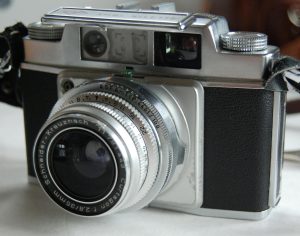
Although no third party lenses were known to be officially made for the Ambi-Silette, at least one Schneider Curtagon 35mm f/2.8 lens is known to exist with an Ambi-Silette mount. The 6-element Curtagon is quite a bit larger than the Tessar based Ambion, but is not only faster and sharper, it also focuses down to 2 feet. This lens is in the collection of Wes Loder and is discussed on his website. At first glance, this lens looks to be a hacked together Kodak Retina lens, however the lens flange has the inscription “AGFA-TYP 4401/100” which suggests this may have been some type of factory prototype.
There were two types of Ambi Silettes produced, a Type I and Type II version. The Type II appeared in 1959, likely with the release of the 130mm f/4 Color-Telinear lens. The most significant change to the camera was a revised rangefinder with a 5mm wider base, likely to accommodate the larger 130mm lens and improve focus accuracy. Other changes include:
- Addition of strap lugs
- 35mm Frame Lines disappear when 90mm Frame Lines are selected
- Change in order of Frame Lines from 35-50-90 to 50-35-90
- Exposure counter changed from additive to subtractive order
- Cosmetic changes to the film advance lever and film reminder dial
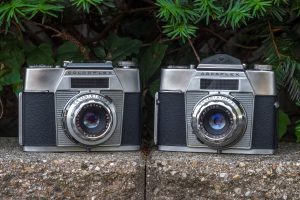
The Ambi Silette wasn’t in production for long, and there’s no concrete evidence of how many were made, but camera historian Michael Wescott Loder suggests in his article that the number is probably around 80,000. Although the Ambi Silette likely ended production in 1961, in my research for this article, I noticed that it disappeared from magazine advertisements around 1959 so perhaps it was withdrawn from the US market at that time. By 1959, AGFA was likely concentrating on their lower cost Optima rangefinders and AGFA/Color/Ambiflex SLRs as demand for high spec rangefinders was falling.
Today, there is a small but loyal following for the Ambi Silette. While very few AGFA cameras are at, or near the top of most collector’s wish lists, the Ambi Silette offers quite a bit of intrigue. Not only was it a well designed and capable model, it seems to have been one of AGFA’s last efforts to produce a world class camera.
My Thoughts
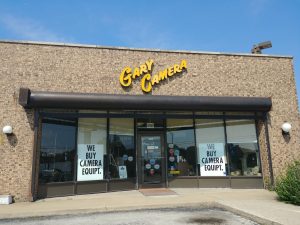 This camera is one that came to me after visiting my friend Barry at Gary Camera in Merrillville, Indiana. This store is but a 20 minute drive from my house and after a recent visit, I spotted this Ambi Silette that he had just taken in from a customer. The camera seemed to be in good working order, so I convinced Barry to loan it to me along with the 35mm Color-Ambion lens for a quick review.
This camera is one that came to me after visiting my friend Barry at Gary Camera in Merrillville, Indiana. This store is but a 20 minute drive from my house and after a recent visit, I spotted this Ambi Silette that he had just taken in from a customer. The camera seemed to be in good working order, so I convinced Barry to loan it to me along with the 35mm Color-Ambion lens for a quick review.
The Ambi Silette is a fascinating camera that when you first pick it up, immediately becomes clear is a step up from the typical late 50s/early 60s AGFA camera. Compared to the various Optima cameras I’ve held, the Ambi-Silette feels solid and “dense” with no apparent weight saving materials used in it’s construction. In the short time I had it, I never thought to put it on a scale to weigh it, but I would guess that it’s probably somewhere between 600 and 700 grams which certainly isn’t over the top, but it’s no lightweight either.
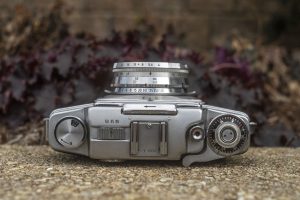
The top plate of the camera has all of the standard things you’d expect to see, a pop up rewind knob, accessory shoe for mounting a flash or auxiliary viewfinder, a threaded shutter release button, and a film advance lever with manually resetting exposure counter on top.
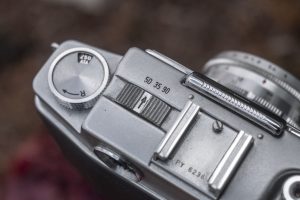
Between the rewind knob and accessory shoe lies the camera’s most interesting feature, the sliding switch for changing between 50mm, 35mm, and 90mm frame lines in the viewfinder. The exact order of the numbers doesn’t make a lot of sense, so my guess is that it is in that order for some practical reason in how the mechanism is designed.
The viewfinder has an overall pinkish tint which contrasts nicely with the yellow circular rangefinder spot and 3 sets of yellow frame lines, one each for the three focal lengths, but strangely at the 50mm setting, both the 50mm and 35mm frame lines are visible. There is no way to only see the 50mm lines by themselves. Even stranger, when the Ambi Silette was first released, the original versions showed the 35mm frame lines on all three focal lengths, even 90mm.
This likely frustrated some users as the 50mm lens came standard with the camera and is the most common lens found, so it’s a bit of a disadvantage to have to use only a small portion of the overall image to compose a 50mm image. I think it would have made more sense to adopt the entire viewfinder image to be 35mm and use the larger frame lines for 50mm. The 90mm frame lines are smaller still, and shortly after it’s release, AGFA produced an AGFA Telinear 130mm f/4 lens which required the use of an auxiliary viewfinder.
With those small complaints aside, I quite liked the Ambi Silette’s viewfinder with the Ambion 35mm f/4 lens as it uses the outer frame lines and therefore the largest amount of visible space.
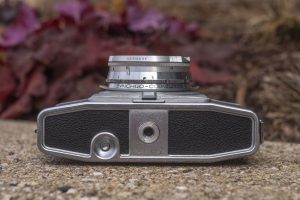
Flip the camera over, and you’ll find a deeply recessed rewind button, and center mounted 1/4″ tripod socket.
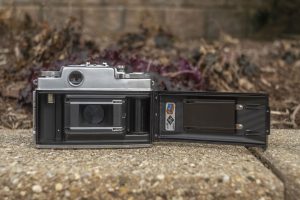
Opening the film compartment is a matter of sliding the door lock on the left side of the camera, and the right hinged door swings open. Lift up on the rewind knob to clear the fork for a new cassette and film loads from left to right onto a single slotted fixed take up spool. Notice AGFA’s little advertisement for their own film on the inside of the film door.
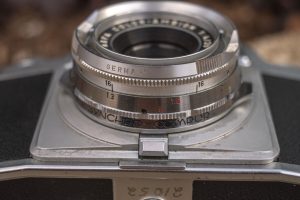
The Ambi Silette has a unique clamp lens mount that allows you to switch between a couple of different lenses available for it. To detach the lens from the body, you simply have to press in the release catch at the base of the lens while simultaneously rotating the lens counter clockwise.
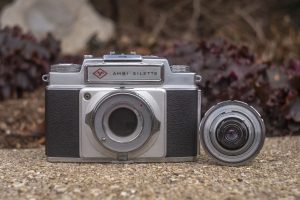
Reattaching the lens to the camera is about as simple as it gets. Simply press the lens back onto the mount and keep turning clockwise until you hear two clicks. The user manual describes a second method to do it, but that second method just has you line up two red dots, one on the lens and one on the mount and then twist it together. Frankly, the red dots aren’t needed at all as you can simply just rotate the lens until it locks into place.
Of all the things to like about the Ambi Silette, there’s one thing I really don’t like, which is the flip up “door” that is on the front face of the camera covering the viewfinder and rangefinder windows. Although it doubles as an attractive billboard with the camera’s name on it, I can’t see any practical purpose of it, other than to get in the way of the photographer.
Edit: Shortly after posting this review, a few collectors pointed out that in it’s up position, the flap provides shade for the viewfinder and rangefinder window, helping to reduce glare in the viewfinder. Shooting the camera downtown Chicago on a cloudy winter day meant that there was no sunlight, so this didn’t become apparent to me, but I’d have to agree that this would be useful.
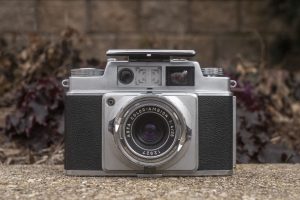
To open the door, you must slide the top hinge of the door as visible from the top plate of the camera and then the spring loaded door will automatically swing up to it’s erect position. While this is hardly difficult, with the door perpetually sticking up above the top plate of the camera, it can easily catch on other things while handling the camera. To avoid this, you either have to be constantly mindful of the door, or keep closing and reopening it after and before each shot. Alternatively, you could just remove the door together, which is what I suspect at least some owners of this camera did.
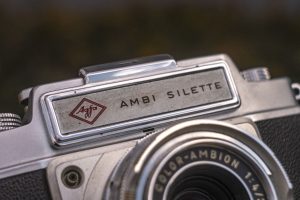
Even if the the door provides shade for the viewfinder, it’s not a feature that I’ve seen on any other rangefinder and only seems to resolve a problem that doesn’t really exist. A door like this was common on cameras with in-body selenium light meters like the Kodak Retina IIIc, Zeiss-Ikon Contessa 35, or Anscomark M, but there’s no meter on the Ambi Silette.
Putting aside the flap, the Ambi Silette is still a very well built German camera that offered a good bang for the buck. It had a flexible viewfinder, supported interchangeable lenses, and came with a lifetime guarantee, what more could you ask for?
My Results
Knowing my time with the Ambi-Silette was short, I took an opportunity to visit Central Camera in Chicago, IL in early 2019 to shoot a roll of bulk Arista.EDU 100 film that I had laying around. Although the Arista.EDU film was fresh and didn’t require any exposure compensation, the film had scratches running all throughout the roll which show up in some of the images below. I was able to use a clone tool in Photoshop to edit them out in some images, but they persist in others and is not indicative of the camera.
Although I didn’t realize it at the time, my chance opportunity to visit Central Camera in Chicago’s Loop with the Ambi Silette and 35mm Ambion lens turned out to be an excellent opportunity to practice street photography. Although a rangefinder camera, the extreme depth of field afforded by the wide angle lens meant I almost never had to mess with focus. Nearly every shot seen here is taken at or near the lens’s hyperfocal distance of about 20 feet.

Needless to say, the images I got from that one and only roll of Arista turned out fantastic. As you might expect from a lens made by AGFA at the peak of the company’s best German cameras, sharpness and contrast are about as good as anything out there. Vignetting was surprisingly low, especially considering the nature of a wide angle lens. Arista.edu film is known to be a budget film primarily targeted to students, but I was quite impressed with the images I got. I rolled something a little short of a 36 exposure roll, and of those, somewhere between 28-30 exposures turned out great as seen in the gallery above.
It was a good thing that I didn’t need to adjust focus that often on the camera as the 35mm Ambion lens is very thin, almost like a pancake lens, which means the focus ring is only 2mm wide and difficult to locate quickly on a whim. As with everything, there’s a trade off with thin lenses like this as they become more pocketable, but harder to use.
When I did need to compose an image through the viewfinder, having the 35mm frame lines as the “default” focal length made getting everything I wanted into frame a snap. While 50mm lenses are much more common on rangefinders, I find that they’re just a bit too tight for spontaneous street shots.
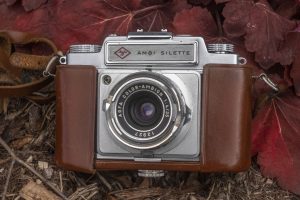
As I had noted in handling the camera prior to shooting with it, the flip up door covering the viewfinder was a nuisance, even if it does offer shade from direct sunlight. Thankfully, I shot a majority of these images within an hour of each other, which meant I could just leave the door open while it hung from a strap around my neck. While the Ambi Silette would likely never be an every day shooter for me, I think that if I was a photographer in the 1960s who was considering buying this model, removing that door would have been a day one decision.
Of course things like a door flap and narrow focus ring are mere nit picks to an otherwise great camera. Considering the camera’s bargain price compared to higher end German rangefinders like the Leica M3 and Voigtländer Prominent, the Ambi Silette is a heck of a bargain, and frankly does everything most photographers would ever ask of those more expensive cameras.
The Ambi Silette turned out to be the peak of AGFA’s interchangeable rangefinder development, and while not up to the impressive specifications, pioneering history, or top of the line build quality of a Leica or Contax rangefinder, it is still a very good camera, and one that you should consider the next time you’re looking to try out a mid 20th century German camera, but want something just a little different.
Related Posts You Might Enjoy
External Links
http://camera-wiki.org/wiki/Ambi_Silette
https://wesloderandnikon.blogspot.com/2019/06/the-ambi-silette-agfas-most-ambitious.html
https://www.usedcameracameracamera.com/camera/ambi-silette/ (in Japanese)
https://www.cameraquest.com/agfambi.htm
https://www.casualphotophile.com/2018/10/15/agfa-ambi-silette-35mm-camera-review/
https://simonhawketts.co.uk/2016/02/17/ambi-silette-35mm-camera/

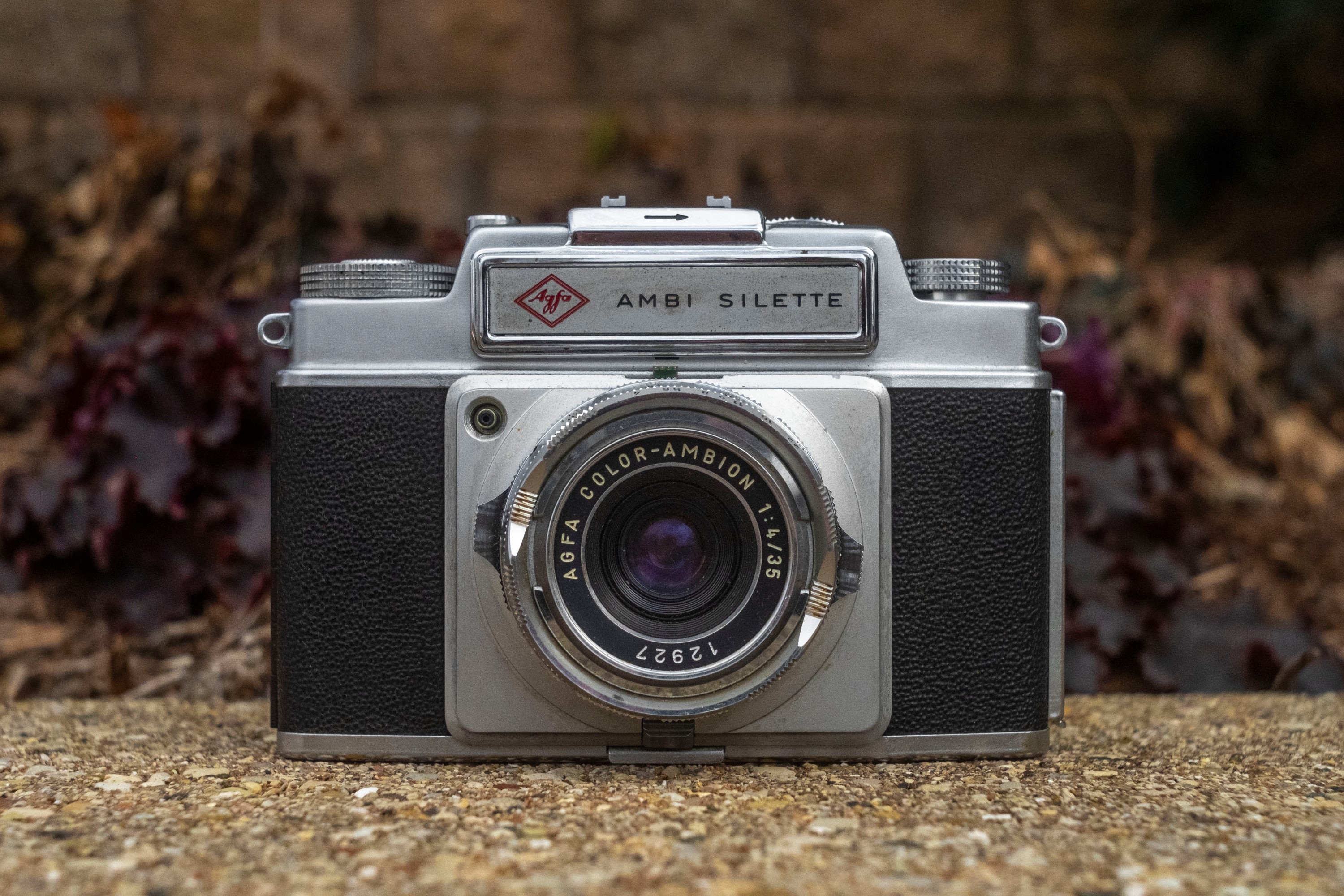
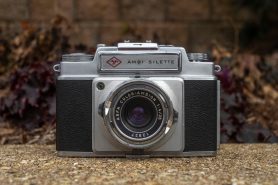
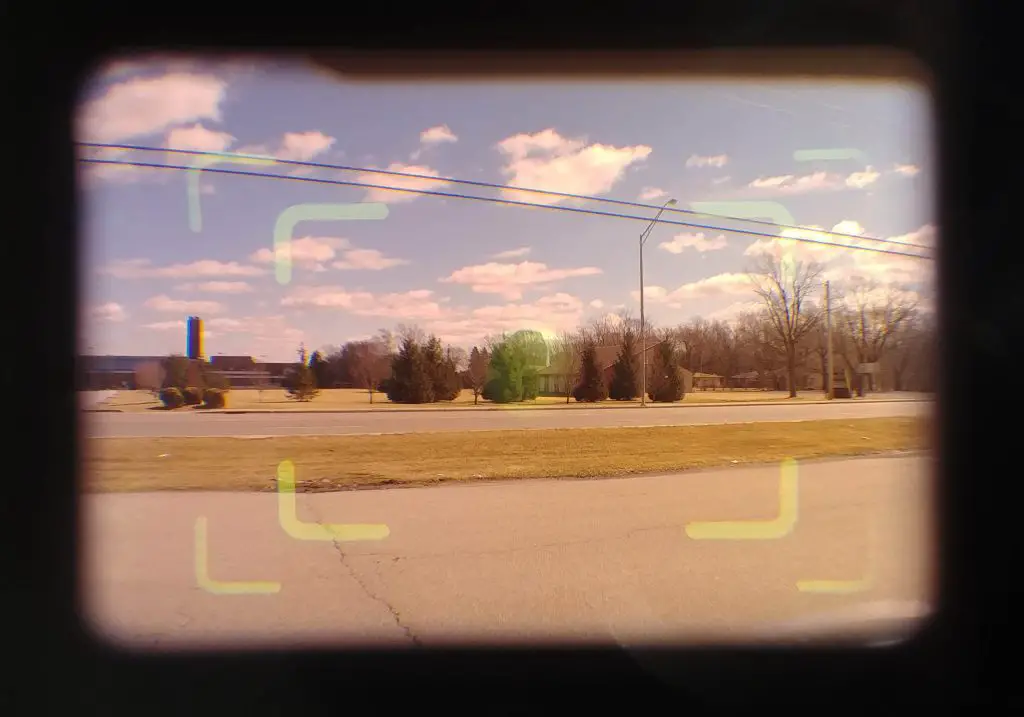
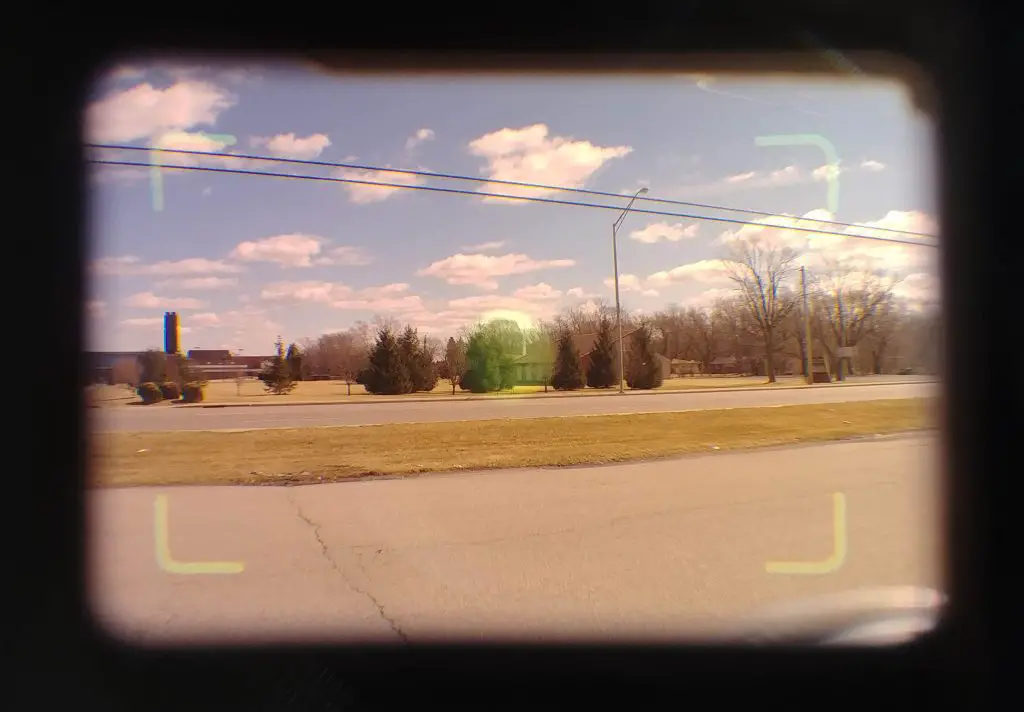
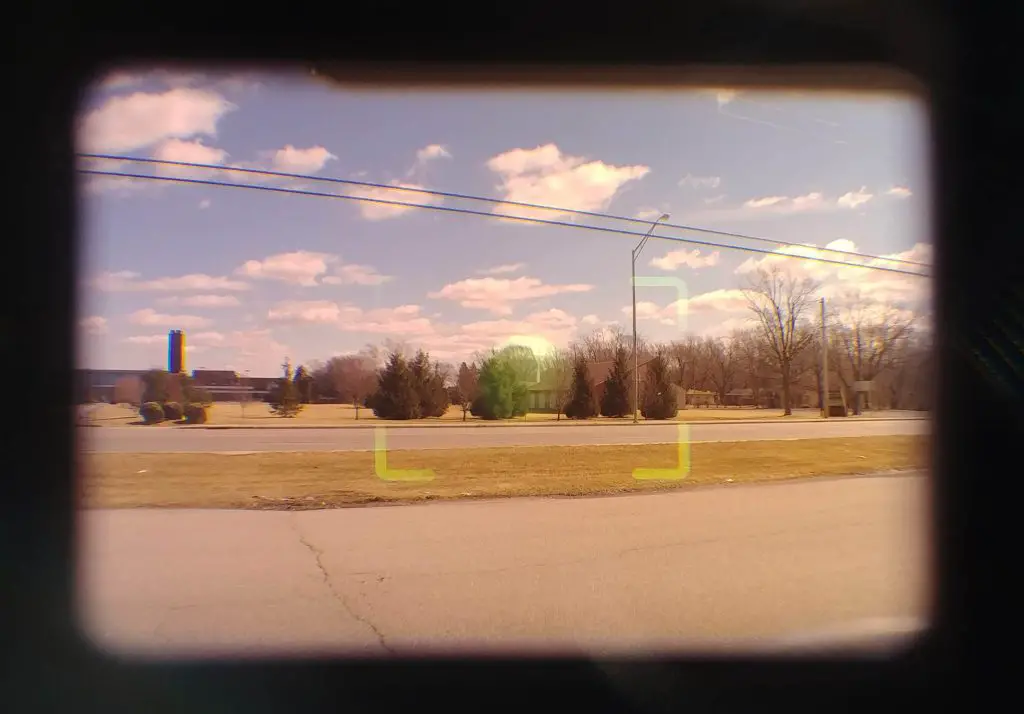












I just got mine out of storage yesterday!
Woohoo! Share your results! 🙂
I’m surprised at the excellent results of the wide angle 35mm lens, seems better than my 35/5.6 component lens for my Retina, even stopped down hard. What aperture were you mostly at?
As I was shooting outdoors in heavy shade, I mainly stuck to f/5.6 or f/8. I almost always use Sunny 16 when shooting these old cameras.
Nice images from the Color-Ambion. Especially enjoy the image taken inside of Central Camera. What a treat!
Thanks for the compliments. The clerk behind the counter at Central Camera is Johnny Sisson of the Classic Lenses Podcast and the Vintage Camera Collectors Group on Facebook. I try to get up there a couple of times a year to visit him at work!
Nice review Mike. I’ve had this complete system for about 15 years and will have to say, the best rangefinder in any camera ever. It is almost fluorescent.
Also have a Super Silette with the 50/F2 Solagon. Many have lamented the fa ct that Agfa did not offer that last as an upgraded option for the Ambi. It sure would have been nice as that camera is a beauty also.
Regards,
My only experience with the Solagon is on a Karat, but I definitely agree that it would have been great had that been an option on the Ambi Silette. Perhaps adapting that lens formula to an interchangeable lens mount was too great a cost. I have to imagine that AGFA’s beancounters had a say in which lenses would be made available!
I adore this camera and have the full kit (both models, all four lenses, close up attachments and color filters).
I take it on every trip (last trip was Taiwan last month) and go through at least 10 rolls of film each time. It takes beautiful photos.
This camera also gets the most compliments from people. It is perfect for street photography as it’s very discreet and the shutter is the most silent I’ve heard.
My cameras are in need of some love though, and finding someone in Australia who can help has been really hard. My last resort is a guy in the UK, or another guy in the US.
It’s my everyday camera. I use it more than my expensive Minolta CLE!
I agree, the Ambi Silette is great for street photography, especially with the 35mm wide angle lens.
For repairs, I have no concept of what postage is like between Australia and New Zealand, but you might want to consider trying to contact Chris Sherlock at retinarescue.com. Although he specializes in the repair of Kodak Retinas, he will take on other jobs if you contact him first. He may be able to take a look at your Ambi Silette. I know he does excellent work!
Hi Mike. I just wanted to share that Chris Sherlock was able to repair the two Ambi-Silettes for me. The experience was really great. I absolutely recommend him to anyone 🙂
That’s great to hear! Although Chris is super knowledgeable about Retinas, sometimes people forget he can repair other kinds of cameras as well. Glad to hear he got your Ambi Silette’s sorted out!
Hi Mike!
Just leaving a comment that I got my hands on the rare ‘De Luxe’ camera body recently. She’s a beauty!
I still take an Ambi with me everywhere I go and never tire of just how beautiful the images are.
I noticed that prices are starting to go up on this gem of a camera. Hopefully that means more people are finding out how wonderful this camera is.
I was just reading your interview article with him. I’m happy to give anything a shot, so I’ll send him an email. Thanks
I too love the Ambi Silette, and bought mine for the look, w/o the name plate (removed)… so wasn’t sure which Agfa model I was getting at first…..,
My rangefinder will not align at infinity, so a bit of cleaning is in order, then I’ll try it out.
As usual, I love your review, and it’s always wonderful to see my “home” Chicago’s Loop, where I worked for many years, at the old “Movie Palaces”
when they still showed film, in the 70’s.
Have you been to Central Camera since the BLM break-in and fire …… terrible….. how does it look today?
Anyway, thanks for ally your great reporting!
Don L
Thanks for the comments, Don! Rangefinder alignment is always a challenge on these cameras. If you like your Ambi Silette, I definitely recommend seeking out a repair technician who can properly service it for you as these German AGFAs are not easy to work on.
As for Central Camera, no, I haven’t been up there since the place burned down, but I was just on a podcast with Johnny Sisson who works there and he gave an update that the new store is occupying the space next to the original store, but that restoration efforts in the original location are ongoing. If you find yourself downtown Chicago, you should stop in an pay them a visit!